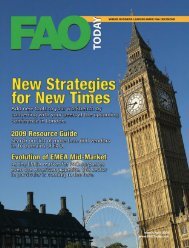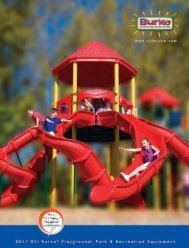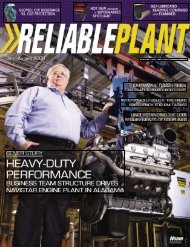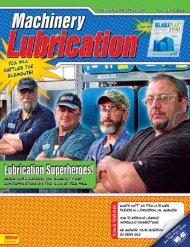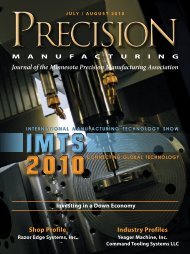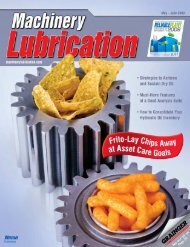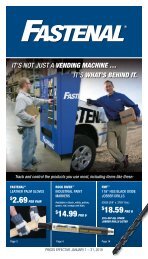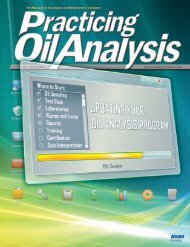Machinery Lubrication July August 2008
Machinery Lubrication July August 2008
Machinery Lubrication July August 2008
Create successful ePaper yourself
Turn your PDF publications into a flip-book with our unique Google optimized e-Paper software.
CASE STUDY<br />
according to Kubera, “It wasn’t filtered. Oil drums were reused<br />
by the manufacturer and could contain contaminants.”<br />
After<br />
Now, the 55-gallon drums are delivered into the oil room<br />
and the oil is pumped into the containers in the storage and<br />
dispensing system, which is arranged in two rows, one on top<br />
of the other, of 12 containers each (Figure 1). Each of the 24<br />
lightweight 65-gallon capacity aluminized steel containers<br />
holds a different oil, and is clearly labeled with the name and<br />
grade of the product.<br />
The 10 gallons of additional capacity that each container<br />
holds enables all of the product to be pumped out of the 55-<br />
gallon drums and into the system. Each container also has a<br />
Figure 2. Quick-coupling Filter Assembly<br />
sight gauge that clearly shows the level of lubricant in it. This<br />
feature makes inventory control easier and eliminates the<br />
need to have extra product standing by.<br />
“The container system was easy to put up,” Kubera said. “The<br />
dispensing manifold, drip pan, pump, motor and timer came<br />
preassembled and tested from the factory, and we were able to<br />
assemble and install it fairly quickly. It has made pumping<br />
product a lot easier, and it has a nice, clean, orderly appearance.”<br />
No Cross-contamination<br />
A key reason for the installation of the system was to<br />
prevent cross-contamination. A product is filtered as it is<br />
pumped into the numbered containers by the quick-coupling<br />
filter assembly through a corresponding numbered valve<br />
arrangement underneath the containers (Figure 2). This<br />
helps to ensure that the lubricant the technician is getting is<br />
exactly what has been requested.<br />
Drip pans contain all spills. In place of the standard<br />
screened vents, each row of tanks has the vent fittings piped<br />
to a Des-Case desiccant breather installed on the side of the<br />
container system, one per row. This way, whatever contaminants<br />
that may be in the ambient air (especially moisture) are<br />
not drawn into the containers when the oil is discharged. This<br />
ensures that the air entering the containers is always clean.<br />
“Cross-contamination from one type of oil to another is one<br />
of the biggest problems,” Kubera said. “We ensure that no two<br />
different oils from different families ever touch each other.” With<br />
this system in place, the oil is filtered at three microns.<br />
The plant prides itself on the detailed procedures it has in<br />
place to make sure the wrong lubricant is never dispensed.<br />
Electronic Lube Manual<br />
“We created a comprehensive Electronic Lube Manual<br />
(ELM) that ensures procedures are followed down to the last<br />
Figure 3. Container with MSDS Label<br />
Figure 4. Poly Containers<br />
24 <strong>July</strong> - <strong>August</strong> <strong>2008</strong> machinerylubrication.com <strong>Machinery</strong> <strong>Lubrication</strong>



